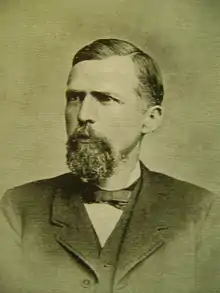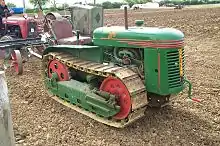Charles Dinsmoor
Charles Dinsmoor (September 19, 1834 – April 11, 1904) was a nineteenth-century American inventor and lawyer. He was admitted to the bar in Pennsylvania. He served in several government-related positions and participated in community social affairs related to education. As an inventor Dinsmoor was involved with patenting the continuous track tractor, which is the forerunner of the tracked vehicles used in construction and the military.
Charles Dinsmoor | |
|---|---|
 | |
| Born | 19 September 1834 |
| Died | 12 April 1904 |
| Resting place | Warren, Pennsylvania |
| Nationality | American |
| Occupation | lawyer |
| Known for | lawyer |
| Political party | Democrat |
| Spouse(s) | Elizabeth C. Morrison, m. 1861 |
| Children | Imogen G Loten A. Harry Frederick |
| Parent(s) | George F. Dinsmoor Catharine (Harper) Dinsmoor |



Early life
Dinsmoor's ancestors came from Ireland but are from Scottish descent.[1] Dinsmoor was born at Alabama Center in Alabama, New York, on September 19, 1834.[1] Dinsmoor's family genealogy can be traced back to the first person in his family history to arrive in America, John Dinsmoor. John came to America in 1719 from Londonderry, Ireland and is the fifth-generation ancestor to Dinsmoor. He originally settled in Windham, New Hampshire.[2]
Among the ancestors of Dinsmoor are Samuel Dinsmoor, who was a governor of New Hampshire and a member of Congress in 1811 and 1812, and who was a son of John Dinsmoor. Samuel Dinsmoor, Jr. was also a governor of New Hampshire.[2] Robert Dinsmoor, brother to Samuel Dinsmoor Sr., was a well-known Scottish poet of New England that called himself the "Rustic Bard."[1] William B. Dinsmoor was the president of the Adams Express Company. Colonel Silas Dinsmoor was famous as an Indian agent.[1] A son of Samuel Jr. was George (born 1794 in Keene, New Hampshire), the father of Dinsmoor. He was a farmer and lumberman.[3] Dinsmoor's mother was Katherine Harper from an English family line.[3]
Dinsmoor received a minimal education in the local common schools of Elk township in Warren County, Pennsylvania, when he was growing up.[4] Much of his time was spent helping support the large family living in meager circumstances. At sixteen Dinsmoor left home and became a student at Warren, Smethport, and Coudersport, Pennsylvania. He was also a student at Randolph, New York.[4] He was in the printing business for about eleven years in the same cities. The printing he did while teaching and attending school. During the last three of this time he was editor of the "Warren Ledger" at Warren, Pennsylvania.[1] He became its associate editor in 1861 and was in that position until 1863.[5]
Mid life
Dinsmoor attended Randolph Academy for a year when he was twenty-two years old. There he studied law for six months at the offices of Weeden & Henderson. Dinsmoor then continued his law studies under B. W. Lacy in 1858. He was admitted to the bar of Warren County, Pennsylvania, on September 18, 1859. Dinsmoor was appointed assistant United States marshal in 1860. One of his duties was taking the 1860 census for the northern half of Warren County. Dinsmoor was elected justice of the peace for Warren County in 1861 and was successively reelected for fifteen years. He also practiced law during that time. In 1876 he voluntarily retired from the judicial office.[1][6]
Dinsmoor has been elected to many positions in government, from being a town clerk to a chief burgess. In 1878 he was elected to the office of school director and held that position for many years. He contributed much to bring about standards for the schools of Warren. Dinsmoor was for several years on the Board of Control and treasurer of Struthers Library Association. Dinsmoor was a lawyer in the Supreme Court of the state of Pennsylvania and the United States Circuit and District Courts. Dinsmoor has been associated with the order of Odd Fellows from 1868 for many years and was grand master of Warren Lodge No. 339.[7]
Later life
Dinsmoor practiced law without a partner for many years. Later he became associated with James Cable and formed the partnership Dinsmoor & Cable. Later when Cable died the firm's name changed to Dinsmoor & Peterson. After Peterson died Dinsmoor conducted business by himself for several years until his health failed. The last five years of his life he had failing health until he died April 11, 1904.[4]
Personal life
Dinsmoor married Elizabeth Morrison in October of 1861. The had four children, Imogen (b. 10/17/1867), Loten (b. 1/25/1870), Harry (b. 8/1/1873), and Frederick (b. 1/13/1875).[7][8]
Notability
Dinsmoor invented the endless chain tractor in 1886,[9][10] a forerunner of the endless tread continuous track vehicle.[11] He received patent No. 351,749 on November 2, 1886.[12] "Dinsmoor's vehicle" was first manufactured commercially by Holt Manufacturing Company of Stockton, California in 1906.[11][13] Dinsmoor Glacier of Antarctica is named after the subject of this article.[14][15]
Footnotes
- Rann 1887, p. 651.
- Rann 1887, p. 650.
- Brown 1911, p. 200.
- "The Death Record". Warren Evening Mirror. Warren, Pennsylvania. April 12, 1904. p. 1 – via Newspapers.com
 .
. - "Warren County genealogy". Retrieved 2020-11-01.
- Cooper 1903, p. 326.
- Rann 1887, p. 652.
- Dwight 1922, p. 461.
- "Detroit in its world setting; a 250-year chronology, 1701-1951". Retrieved 2008-11-19.
- "Vehicle". Scientific American. LV (25): 387. 1886.
- "Endless Tread Tractor Invented in 1886". The Atlantic Constitution. Atlanta, Georgia. July 20, 1971. p. 2 – via Newspapers.com
 .
. - "On This Day / November 2, 1962". Arizonia Republic. Phoenix, Arizona. November 2, 1962. p. 20 – via Newspapers.com
 .
. - Kane 1950, p. 47.
- Stewart 1990, p. 260.
- Alberts 1981, p. 99.
Sources
- Alberts, Fred G. (1981). Geographic Names of the Antarctic. National Science Foundation.
- Brown, George Washington (1911). Old Times in Oildom. Derrick Publishing Company.
- Cooper, H. C. (1903). The Twentieth Century Bench and Bar of Pennsylvania. Brass-Cooper Typsetting Company.
- Dwight, Frederick (1922). Quarter-century Record, Class of 1894 Yale College. Yale University.
- Kane, Joseph Nathan (1950). Famous First Facts. H. W. Wilson Company.
- Rann, William S. (1887). History of Warren County, Pennsylvania. D. Mason & Company.
- Scientific American, December 18, 1886. Vol. LV., No. 25
- Stewart, John (1990). Antarctica: An Encyclopedia. McFarland. ISBN 9780899505978.
Further reading
- Richmond, George, President, Biographical Publishing Company, Book of Biographies - Biographical Sketches of leading citizens of the 37th judicial district, Pennsylvania (Charles Dinsmoor) Buffalo, N.Y., 1899